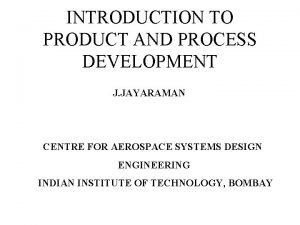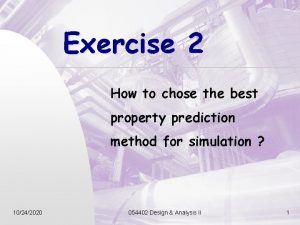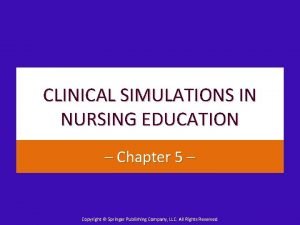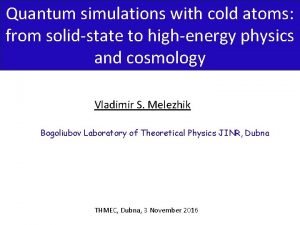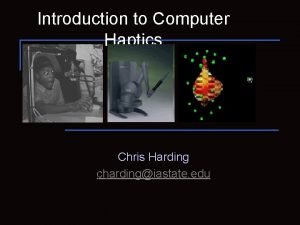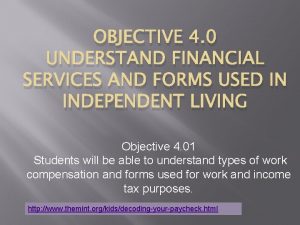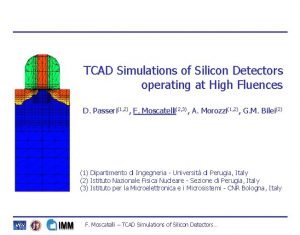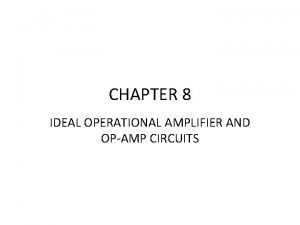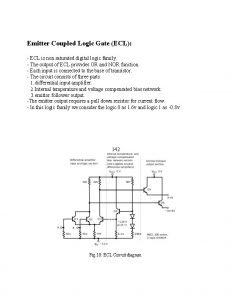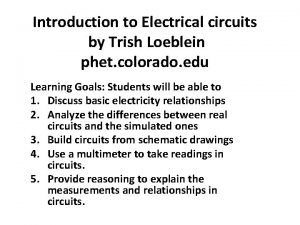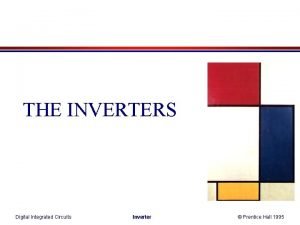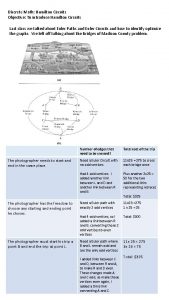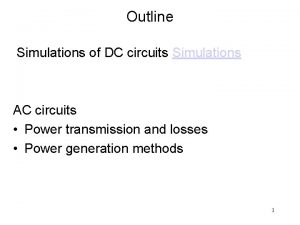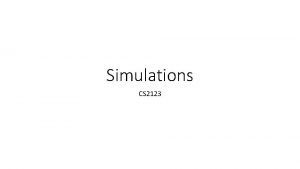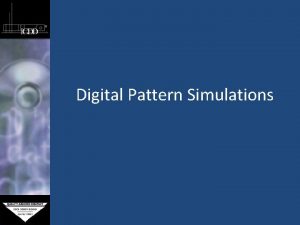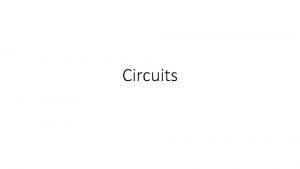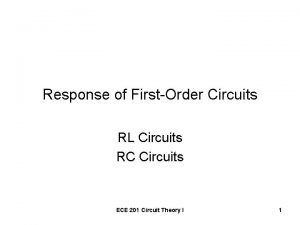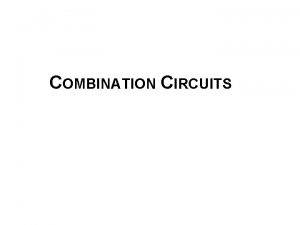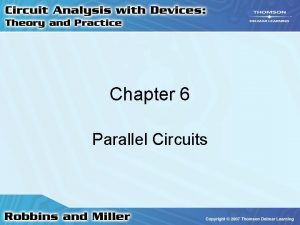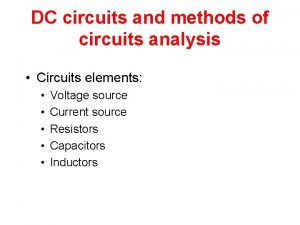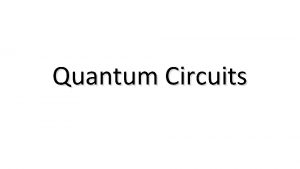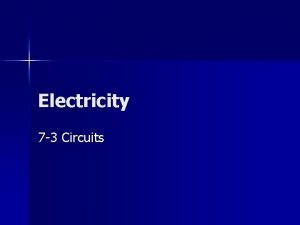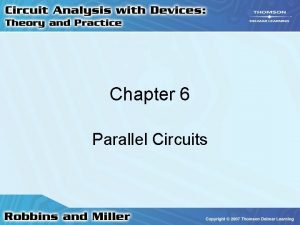Outline Simulations of DC circuits Simulations AC circuits


















- Slides: 18

Outline Simulations of DC circuits Simulations AC circuits • Power transmission and losses • Power generation methods 1

What’s Alternating Current (AC)? • Wall plugs deliver ac currents. • The magnitude and direction of the current change periodically, 60 times a second. • Turbines generate ac voltage (solar cells generate dc voltage). a b ~ • With f = 60 s-1 2

DC and AC Currents DC V(t) = V 0 I(t) = I 0 R + - AC V(t) = V 0 sin(2 f t) I(t) = I 0 sin(2 f t) Peak voltage: V 0 Peak current: I 0 a b ~ 3

How Are AC Currents Generated? • Electricity is generated from transforming other forms of energy. • The final step often involves converting mechanical energy into electrical energy using an electrical turbine. • For example: Coal is combusted and thermal energy is used to produce steam at high pressure that drives a turbine. • Rotating turbine is attached an electrical generator. Turbine (with top taken off) undergoing maintenance 4

How Does an Electric Generator Work? • Rotating turbine attached to electrical generator, which essentially is a wire coil rotating in a magnetic field. • The free electrons inside a wire that is moving through a magnetic field experience a force. They start moving and we get a current to flow in wire coil. (Simulation Faraday's Lab ). • Since wire coil repeatedly is exposed to North and South pole of magnet while rotating, the current direction (and magnitude) changes: We obtain an AC current. 5

Why AC not DC? • Usually dc currents are used inside your electronic devices. So why don’t we get dc currents into our homes? 1) AC voltages are easy to transform between high and low voltages. (Simulation) 2) Need 120 V in our homes but 650, 000 V for efficient power transmission from the power station (later). Until recently, this was difficult to do with dc voltages. 6

How Can An AC Circuit Do Work? • In an ac circuit conduction electrons oscillate, moving back and forth around their equilibrium position. • Work is still done. Consider electrons in the filament of a light bulb. Moving electrons still transfer energy into heat and light radiation in collisions. Similar to friction that is always opposite to motion • So no matter if the motion is in one direction (dc) or a back-and-forth motion (ac), the conduction electrons collide with the bound electrons and we have resistance and power transfer. • Consequently, resistance is still defined as R = V/I, and we have the same laws for power dissipation in ac and dc circuits. 7

Transmission Lines Power Transmission line resistance RT Station Load (City) Power P needed at voltage V Voltage Simplified Equivalent Circuit RT V~ VL , PL 8

Transmission Lines • For resistor circuits, same rules for ac and dc currents. • Power lost in transmission line is PT = R T I 2 • The current is the same in the transmission line and in the load so we can express the current using the power: • PL = V L I so I = PL/VL • PT = RT (PL/VL)2 we can use V VL, if RT is relatively small. RT VL , PL V~ 9

Transmission Lines • Power loss approximately is: • Consequences: to minimize resistance (copper: expensive) and maximize voltage for smallest possible loss. • The power lost in transmission line is inversely proportional to the (voltage)2. i. e. we double the voltage, we expect to reduce the power loss by a factor of 4. 10

Transmission Line at 650, 000 V • • • Transmitting P = 0. 5 GW at 650 000 V I = 500 000 W/650 000 V ≈ 750 A Resistance 0. 31 Ω/km Length 50 km Total resistance RT = 15. 5 Ω Voltage drop over the transmission line: DV = RT I = 11625 V, so VL V • Power loss P = I 2 RT ≈ 9 MW • 9 MW/(500 + 9) MW = 1. 77% 11

Transmission Line at 325, 000 V • • Transmitting P = 0. 5 GW at = 325 000 V I = 500 000/325 000 ≈ 1500 A Resistance 0. 31 Ω/km Length 50 km, Total resistance RT = 15. 5 Ω Power loss P = I 2 RT ≈ 35 MW/535 MW = 6. 54% 6. 54/1. 77 = 3. 7 in fair agreement with expectation. 12

How Much Copper? • Resistivity of copper ρ = 17. 2 nΩ m. • Typical transmission line (4 wires): R = 0. 31Ω/km. • R = ρ d/A = ρ d/(π r 2) • So r 2 = ρd/π R = 4·1000 m · 17. 2·10 -9Ωm/(3. 14 · 0. 31Ω) • r = 8 mm • d = 16 mm + steel cladding • Size is a compromise between low resistance and high cost of copper, weight issues, etc. 13

Electrical Power Generation • • • Hydro power Energy storage Wind power Solar cells Thermal generating stations Comparison: Cost and environmental concerns. 14

Hydro Power Gravitational potential energy is transformed into electrical energy. Power = Energy/Time P = Dm g h/Dt So the power depends on the amount of the water per unit time. Using the density r = m/V (1000 kg/m 3 for water), we obtain P = r g h (DV/Dt) The term in brackets is the flow rate, which is a volume per unit time, measured in m 3/s. 15

Wind Turbines 16

Wind Power • Wind energy is in form of kinetic energy: K = ½ m v 2 • Similarly to flowing water in a hydro power station, it makes sense to express the mass in terms of a flow rate and consider power: • P = K/t = ½ Dm/Dt v 2 • Using the density (r = 1. 28 kg/m 3 for air): P = ½ r (DV/Dt) v 2 • Important for the windmill is the amount of wind that moves through the area A defined by the rotor blades: DV/Dt = A Dx/Dt = A v. 17 • P = ½ r A v 3

Wind Power: Le Nordais Wind Turbine This is data from a online text. We can proof that it’s wrong! P = ½ r A v 3 (available power) = 28. 5 k. W (at 15 km/h) = 1. 12 MW (at 51 km/h) 18
 What is a parallel circuit in physics
What is a parallel circuit in physics Lesson outline lesson 3 describing circuits answers
Lesson outline lesson 3 describing circuits answers Ippd key tenets
Ippd key tenets Yes or no
Yes or no World history simulations
World history simulations Baton simulations
Baton simulations Clinical simulations in nursing education
Clinical simulations in nursing education Simulations for solid state physics
Simulations for solid state physics Chris harding simulations
Chris harding simulations Payroll card
Payroll card Tcad simulations
Tcad simulations Topic sentence outline example
Topic sentence outline example Venn diagram of active and passive voice
Venn diagram of active and passive voice Gain of non inverting amplifier
Gain of non inverting amplifier Décodeur 3 vers 8
Décodeur 3 vers 8 Ecl gate
Ecl gate Phet circuit
Phet circuit Integrated circuits
Integrated circuits Discrete math circuits
Discrete math circuits


